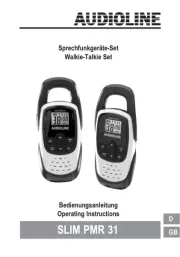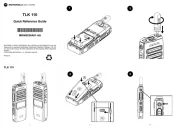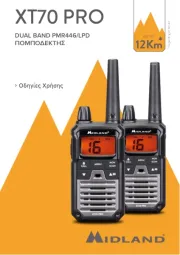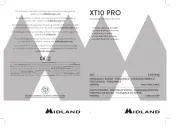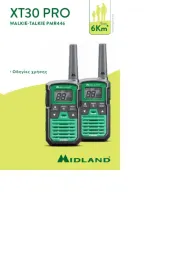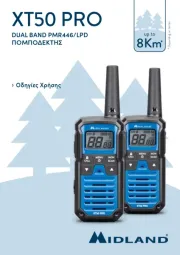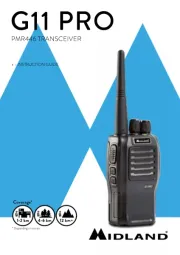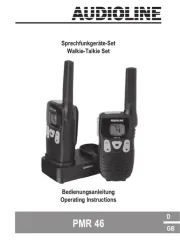AVISOS AL USUARIO
◆La ley gubernamental prohíbe la operación de radiotransmisores no autorizados dentro de los
territorios que se encuentren bajo el control del gobierno.
◆La operación ilegal se castigará con multa y/o encarcelamiento.
◆Solicite la reparación solamente a un técnico cualifi cado.
Seguridad: Es importante que el operador conozca y entienda los peligros comunes derivados del uso de
cualquier transceptor.
ADVERTENCIA
◆AMBIENTES EXPLOSIVOS (GASES, POLVO, HUMOS, etc.)
Desconecte el transceptor mientras abastece combustible, o cuando haya estacionado en una
gasolinera. No transporte recipientes conteniendo combustible de recambio en el portaequipajes de
su vehículo si p2-ha instalado su transceptor en el área del portaequipajes.
◆LESIONES OCASIONADAS POR TRANSMISIONES DE RADIOFRECUENCIA
No opere su transceptor cuando haya alguna persona cerca o en contacto con la antena para evitar la
posibilidad de que se produzcan quemaduras por alta frecuencia o lesiones físicas relacionadas.
◆DETONADORES DE DINAMITA
La operación del transceptor dentro de un radio de 150 metros de los detonadores de dinamita
podría producir una explosión. Desconecte la alimentación de su transceptor en un sitio donde se
estén haciendo voladuras o donde haya carteles con la indicación “APAGAR LOS APARATOS DE
RADIOCOMUNICACION BILATERAL”. Si está transportando detonadores en su vehículo, asegúrese
de hacerlo en cajas metálicas blindadas con almohadillado interior. No transmita mientras se están
poniendo o sacando los detonadores de sus cajas.
PRECAUCIONES
Observe las siguientes precauciones para evitar incendios, lesiones personales y daños al transceptor.
• No intente confi gurar el transceptor mientras conduce, p2-ya que resulta demasiado peligroso.
• No desmonte ni modifi que el transceptor bajo ningún concepto.
• No exponga el transceptor a la luz directa del sol durante periodos de tiempo prolongados, ni lo coloque
cerca de calefactores.
• Si detecta un olor anormal o humo procedente del transceptor, desconecte inmediatamente la
alimentación y póngase en contacto con su proveedor KENWOOD.
• El uso del transceptor mientras conduce puede infringir las leyes de tráfi co. Consulte y respete el
reglamento de tráfi co de su país.
• No utilice opciones no especifi cadas por KENWOOD.
• No coloque la bolsa de plástico utilizada para el embalaje de este equipo en lugares al alcance de los
niños. Si se coloca sobre la cabeza puede causar asfi x.
• No coloque el transceptor sobre superfi cies inestables.
• Mantenga el volumen lo más bajo posible para proteger sus oídos.
• Apague el transceptor antes de instalar los accesorios opcionales.
PRECAUCIÓN
◆¡El transceptor sólo funciona en sistemas de 12 V con negativo a tierra! Compruebe la polaridad y el
voltaje de la batería del vehículo antes de instalar el transceptor.
◆Utilice únicamente el cable de alimentación CC suministrado o un cable de alimentación CC opcional
de .KENWOOD
◆No corte ni extraiga el porta fusible del cable de alimentación CC.
◆No líe el cable del micrófono alrededor del cuello cuando esté cerca de máquinas que pudieran
atrapar el cable.
◆Al sustituir el fusible del cable de alimentación de CC, asegúrese de sustituirlo por otro con la misma
capacidad. No sustituya nunca un fusible por otro que posea una capacidad superior.
ADVERTENCIA
◆Para la seguridad de los pasajeros, instale el transceptor de forma segura utilizando el soporte de
montaje suministrado u opcional y el juego de tornillos de forma que el transceptor no se suelte en
caso de colisión.
Este Guía del usuario sólo cubre las operaciones básicas de
su radio. Para ver el Manual de instrucciones de detalles,
consulte el siguiente URL o código QR.
http://manual.kenwood.com/files/B5K-0509-00.pdf
La tecnología de codificación de voz AMBE+2™ integrada en este producto está protegida por
derechos de propiedad intelectual incluyendo los derechos de patente, los derechos de autor y secretos
comerciales de Digital Voice Systems, Inc. Esta tecnología de codificación de voz otorga licencia para su
uso únicamente dentro de este equipo de comunicaciones.
Está explícitamente prohibido que el usuario de esta tecnología intente extraer, retirar, descompilar,
realizer ingeniería inversa, o desmontar el código objeto, o convertir de cualquier otra manera el código
objeto a una forma legible para el ser humano. Los números de patente de los EE.UU. #8,315,860,
#8,595,002, #6,912,495, #8,200,497, #7,970,606 y #8,359,197.
Derechos de autor del firmware
El título y la propiedad de los derechos de autor del firmware incorporado en memorias de productos
KENWOOD están reservados para JVC KENWOOD Corporation.
PRECAUCIÓN
SUPERFICIE CALIENTE
No toque la superfi cie metálica del transceptor mientras esté en
uso. Tampoco monte el transceptor de manera que el chasis pueda
ponerse en contacto con la piel.
Las temperaturas altas podrían causar quemaduras.
ACCESORIOS SUMINISTRADOS
Desembale el transceptor con cuidado. Le recomendamos que logre identifi car los elementos que se indican
a continuación antes de deshacerse del material de embalaje. Si falta o p2-ha resultado dañado algún artículo
durante el envío, presente inmediatamente una reclamación a la empresa de transporte.
Artículo
NX-5700
NX-5800
NX-5900
NX-5700B
NX-5800B
NX-5900B Serie NX-3000 TK-D740
TK-D840
Cable de alimentación CC (con fusibles) 1 – 1 1
• Fusible 2 – 2 2
Soporte de montaje 1 – 1 1
Micrófono (con cable) 1 – 1 1
Horquilla del micrófono (con tornillos
autorroscantes de 4 x 16 mm) 1 – 1 1
Juego de tornillos:
• Tornillo autorroscante de 5 x 16 mm 4 – 4 4
• Tornillos de cabeza hexagonal con arandela
de M4 x 6 mm 4 – 4 4
• Arandela de resorte 4 – 4 4
• Arandela plana 4 – 4 4
Guía del Usuario 1 1 1 1
OPERACIONES BÁSICAS
Pantalla
Indicador de estado Altavoz
Indicador TX/RX
Botones operación
Conmutador PTT
Micrófono
Pantalla
Altavoz
Indicador TX/RX Botones operación
Altavoz
Botones operación
Pantalla
Indicador de estado
Indicador TX/RX
ENCENDIDO Y APAGADO
Pulse para activar el transceptor.[ ]
Vuelva a pulsar [ para apagar el transceptor.]
AJUSTE DEL VOLUMEN
Pulse el botón programado como [Subir volumen] para aumentar el volumen. Pulse el botón programado
como para reducir el volumen.[Bajar volumen]
SELECCIÓN DE UNA ZONA Y UN CANAL
Seleccione la zona deseada utilizando las teclas programadas con la función / y [Zona arriba] [Zona abajo]
[Canal arriba] [Canal abajo]/ .
TRANSMISIÓN
1 Seleccione la zona y el canal deseados.
2 Monitor] Desactivar silenciamiento] Pulse la tecla programada con la función [ o [ para comprobar si el
canal está libre.
• Si el canal está ocupado, espere hasta que quede libre.
3 PTT Presione el conmutador y hable al micrófono. Suelte el conmutador para recibir.PTT
• Para obtener una calidad de sonido optima, sujete el transceptor a 3 ó 4 cm (1,5 pulgadas) de la boca.
RECEPCIÓN
Seleccione la zona y el canal deseados. Si se p2-ha programado la función de señalización en el canal
seleccionado, sólo oirá las llamadas en las que la señal recibida coincida con la confi guración del
transceptor.
Recepción de llamadas de grupo (digitales)
Cuando reciba una llamada de grupo en un canal convencional y el ID de grupo recibido coincida con el ID
confi gurado en el transceptor, oirá la voz de la persona que realiza la llamada.
Cuando reciba una llamada de grupo en un canal de trunking, el transceptor pasará automáticamente al
canal de comunicación para recibir la llamada.
Recepción de llamadas particulares (digitales)
Cuando reciba una llamada particular, sonará un tono de timbre y el ID de la persona que realiza la llamada
aparecerá en la pantalla. Para contestar la llamada, presione prolongadamente el conmutador y hable PTT
al transceptor igual que durante una transmisión normal.
© 2018
MANDATORY SAFETY INSTRUCTIONS TO INSTALLERS AND USERS
• Use only manufacturer or dealer supplied antenna.
• Antenna Minimum Safe Distance: Refer to the values in the table below.
• Antenna Gain: 0 dBd referenced to a dipole.
The Federal Communications Commission has adopted a safety standard for human exposure to RF (Radio
Frequency) energy which is below the OSHA (Occupational Safety and Health Act) limits.
• Antenna Mounting: The antenna supplied by the manufacturer or radio dealer must not be mounted at a
location such that during radio transmission, any person or persons can come closer than the minimum
safe distance indicated in the table below.
• To comply with current FCC/ ISED RF Exposure limits, the antenna must be installed at or exceeding
the minimum safe distance shown above, and in accordance with the requirements of the antenna
manufacturer or supplier.
• Vehicle installation: The antenna can be mounted at the center of a vehicle metal roof or trunk lid, if the
minimum safe distance is observed.
• Base Station Installation: The antenna should be fi xed-mounted on an outdoor permanent structure. RF
Exposure compliance must be addressed at the time of installation.
Antenna substitution: Do not substitute any antenna for the one supplied or recommended by the
manufacturer or radio dealer.
You may be exposing person or persons to excess radio frequency radiation. You may contact your radio
dealer or the manufacturer for further instructions.
WARNING
Maintain a separation distance from the antenna to person(s) of at least the distance indicated in the table
below.
You, as the qualifi ed end-user of this radio device must control the exposure conditions of bystanders to
ensure the minimum separation distance (table below) is maintained between the antenna and nearby
persons for satisfying RF Exposure compliance. The operation of this transmitter must satisfy the
requirements of Occupational/Controlled Exposure Environment, for work-related use, transmit only when
person(s) are at least the minimum distance from the properly installed, externally mounted antenna.
Transmit only when people outside the vehicle are at least the recommended minimum lateral distance away
from the antenna/vehicle.
Antenna Minimum Safe Distance
VHF DIGITAL TRANSCEIVER 60 cm (2 feet), 50% duty Cycle
UHF DIGITAL TRANSCEIVER/
700/800 MHz DIGITAL TRANSCEIVER 40 cm (16 inches), 50% duty Cycle
“This transmitter is authorized to operate with a maximum duty factor of 50%, in typical push-to-talk mode, for
satisfying FCC/ ISED RF exposure compliance requirements.”
CONSIGNES DE SÉCURITÉ OBLIGATOIRES DESTINÉES AUX INSTALLATEURS ET AUX
UTILISATEURS
• N’utilisez que des antennes fournies par le fabricant ou le revendeur.
• Distance minimum de sécurité par rapport à l’antenne : Reportez-vous aux valeurs indiquées dans le
tableau ci-dessous.
• Gain d’antenne : 0 dBd par rapport à un dipôle.
La Federal Communications Commission a édicté une norme de sécurité pour l’exposition humaine à l’énergie
des RF (radiofréquences) qui se situe en deçà des seuils fi xés par l’OSHA (Occupational Safety and Health Act).
• Installation de l’antenne: l’antenne fournie par le fabricant ou le revendeur radio ne doit pas être montée
dans un endroit tel que pendant que la transmission par hyperfréquences, des personnes peuvent se
rapprocher de la distance de sécurité minimale indiquée dans le tableau ci-dessous.
• Afi n de respecter les seuils actuels d’exposition aux RF fi xés par la FCC/ ISED, l’antenne doit être
installée à une distance supérieure ou égale à la distance minimum de sécurité indiquée ci-dessus et en
accord avec les exigences du fabricant ou du fournisseur de l’antenne.
• Installation du véhicule : l’antenne peut être placée au centre du toit métallique ou du capot du coffre d’un
véhicule si la distance minimum de sécurité est respectée.
• Installation de la station de base : l’antenne doit être installée sur une structure permanente extérieure.
Les seuils d’exposition à la RF doivent être respectés lors de l’installation.
Remplacement de l’antenne : ne remplacez pas l’antenne par celle fournie ou recommandée par le fabricant
ou le revendeur de la radio.
Vous risquez d’exposer une ou plusieurs personnes à un niveau de radiofréquence excessif. Vous pouvez
vous adresser à votre revendeur ou au fabricant pour plus d’informations.
AVERTISSEMENT
Maintenir une distance de séparation de l’antenne aux personnes d’au minimum la distance indiquée dans
le tableau ci-dessous.
Vous devez, en votre qualité d’utilisateur fi nal qualifi é de cet appareil radio, contrôler les conditions
d’exposition des passants afi n de vous assurer que la distance minimum de séparation (tableau ci-dessous)
est maintenue entre l’antenne et les personnes alentour afi n de satisfaire aux normes d’exposition à la RF.
Le fonctionnement de cet émetteur doit satisfaire aux exigences d’un environnement à exposition contrôlée/
professionnel pour l’utilisation liée au travail, n’émettre que lorsqu’une ou plusieurs personnes se trouvent
à une distance au moins égale à la distance minimum par rapport à l’antenne correctement installée en
extérieur. N’émettez que lorsque les personnes en dehors du véhicule se trouvent à une distance au moins
égale à la distance latérale minimum recommandée par rapport à l’antenne/au véhicule.
One or more of the following statements may be applicable:
FCC WARNING
This equipment generates or uses radio frequency energy. Changes or modifi cations to this equipment
may cause harmful interference unless the modifi cations are expressly approved by the party responsible/
JVC KENWOOD. The user could lose the authority to operate this equipment if an unauthorized change or
modifi cation is made.
INFORMATION TO THE DIGITAL DEVICE USER REQUIRED BY THE FCC
This equipment has been tested and found to comply with the limits for a Class B digital device, pursuant
to Part 15 of the FCC Rules. These limits are designed to provide reasonable protection against harmful
interference in a residential installation.
This equipment generates, uses and can generate radio frequency energy and, if not installed and used in
accordance with the instructions, may cause harmful interference to radio communications. However, there
is no guarantee that the interference will not occur in a particular installation. If this equipment does cause
harmful interference to radio or television reception, which can be determined by turning the equipment off
and on, the user is encouraged to try to correct the interference by one or more of the following measures:
• Reorient or relocate the receiving antenna.
• Increase the separation between the equipment and receiver.
• Connect the equipment to an outlet on a circuit different from that to which the receiver is connected.
• Consult the dealer for technical assistance.
This device complies with Industry Canada licence-exempt RSS standard(s). Operation is subject to the
following two conditions: (1) this device may not cause interference, and (2) this device must accept any
interference, including interference that may cause undesired operation of the device.
(NX-5000/ NX-3000 series)
TRANSCEPTOR DIGITAL
GUÍA DEL USUARIO
Serie NX-5000
Serie NX-3000
TK-D740 TK-D840
INFORMATION ON SOFTWARE LICENSE
This transceiver uses a software according to the following license agreements.
*zlib LICENSE
Copyright (C) 1995-2013 Jean-loup Gailly and Mark Adler
This software is provided 'as-is', without any express or implied warranty.
In no event will the authors be held liable for any damages arising from the use of this software.
Permission is granted to anyone to use this software for any purpose, including commercial applications, and to alter it and
redistribute it freely, subject to the following restrictions:
1. The origin of this software must not be misrepresented; you must not claim that you wrote the original software. If you use
this software in a product, an acknowledgment in the product documentation would be appreciated but is not required.
2. Altered source versions must be plainly marked as such, and must not be misrepresented as being the original software.
3. This notice may not be removed or altered from any source distribution.
Jean-loup Gailly (jloup@gzip.org)
Mark Adler (madler@alumni.caltech.edu)
*libpng LICENSE
This copy of the libpng notices is provided for your convenience. In case of any discrepancy between this copy and the
notices in the fi le png.h that is included in the libpng distribution, the latter shall prevail.
COPYRIGHT NOTICE, DISCLAIMER, and LICENSE:
If you modify libpng you may insert additional notices immediately following this sentence.
This code is released under the libpng license. libpng versions 1.2.6, August 15, 2004, through 1.6.8, December 19, 2013,
are Copyright (c) 2004, 2006-2013 Glenn Randers-Pehrson, and are distributed according to the same disclaimer and
license as libpng-1.2.5 with the following individual added to the list of Contributing Authors
Cosmin Truta
libpng versions 1.0.7, July 1, 2000, through 1.2.5 - October 3, 2002, are Copyright (c) 2000-2002 Glenn Randers-Pehrson,
and are distributed according to the same disclaimer and license as libpng-1.0.6 with the following individuals added to the
list of Contributing Authors
Simon-Pierre Cadieux
Eric S. Raymond
Gilles Vollant
and with the following additions to the disclaimer:
There is no warranty against interference with your enjoyment of the library or against infringement. There is no warranty
that our efforts or the library will fulfi ll any of your particular purposes or needs. This library is provided with all faults,
and the entire risk of satisfactory quality, performance, accuracy, and effort is with the user.
libpng versions 0.97, January 1998, through 1.0.6, March 20, 2000, are Copyright (c) 1998, 1999 Glenn Randers-Pehrson,
and are distributed according to the same disclaimer and license as libpng-0.96, with the following individuals added to the
list of Contributing Authors:
Tom Lane
Glenn Randers-Pehrson
Willem van Schaik
libpng versions 0.89, June 1996, through 0.96, May 1997, are Copyright (c) 1996, 1997 Andreas Dilger Distributed according
to the same disclaimer and license as libpng-0.88, with the following individuals added to the list of Contributing Authors:
John Bowler
Kevin Bracey
Sam Bushell
Magnus Holmgren
Greg Roelofs
Tom Tanner
libpng versions 0.5, May 1995, through 0.88, January 1996, are Copyright (c) 1995, 1996 Guy Eric Schalnat, Group 42, Inc.
For the purposes of this copyright and license, “Contributing Authors” is defi ned as the following set of individuals:
Andreas Dilger
Dave Martindale
Guy Eric Schalnat
Paul Schmidt
Tim Wegner
The PNG Reference Library is supplied “AS IS”. The Contributing Authors and Group 42, Inc. disclaim all warranties,
expressed or implied, including, without limitation, the warranties of merchantability and of fi tness for any purpose.
The Contributing Authors and Group 42, Inc. assume no liability for direct, indirect, incidental, special, exemplary, or
consequential damages, which may result from the use of the PNG Reference Library, even if advised of the possibility of
such damage.
Permission is hereby granted to use, copy, modify, and distribute this source code, or portions hereof, for any purpose,
without fee, subject to the following restrictions:
1. The origin of this source code must not be misrepresented.
2. Altered versions must be plainly marked as such and must not be misrepresented as being the original source.
3. This Copyright notice may not be removed or altered from any source or altered source distribution.
The Contributing Authors and Group 42, Inc. specifi cally permit, without fee, and encourage the use of this source code
as a component to supporting the PNG fi le format in commercial products. If you use this source code in a product,
acknowledgment is not required but would be appreciated.
A “png_get_copyright” function is available, for convenient use in “about” boxes and the like:
printf("%s",png_get_copyright(NULL));
Also, the PNG logo (in PNG format, of course) is supplied in the fi les
“pngbar.png” and “pngbar.jpg” (88x31) and “pngnow.png” (98x31).
Libpng is OSI Certifi ed Open Source Software. OSI Certifi ed Open Source is a certifi cation mark of the Open Source
Initiative.
Glenn Randers-Pehrson
glennrp at users.sourceforge.net
December 19, 2013
*Md5
Copyright (C) 1999, 2000, 2002 Aladdin Enterprises. All rights reserved.
This software is provided 'as-is', without any express or implied warranty.
In no event will the authors be held liable for any damages arising from the use of this software.
Permission is granted to anyone to use this software for any purpose, including commercial applications, and to alter it and
redistribute it freely, subject to the following restrictions:
1. The origin of this software must not be misrepresented; you must not claim that you wrote the original software. If you use
this software in a product, an acknowledgment in the product documentation would be appreciated but is not required.
2. Altered source versions must be plainly marked as such, and must not be misrepresented as being the original software.
3. This notice may not be removed or altered from any source distribution.
L. Peter Deutsch
ghost@aladdin.com
Distance minimum de sécurité par rapport à l'antenne
ÉMETTEUR-RÉCEPTEUR NUMÉRIQUE VHF 60 cm (2 pieds), 50% du cycle de travail
ÉMETTEUR-RÉCEPTEUR NUMÉRIQUE UHF/
ÉMETTEUR-RÉCEPTEUR NUMÉRIQUE 700/800MHz 40 cm (6 pouces), 50% du cycle de travail
“Ce émetteur-transmetteur est autorisé pour fonctionner avec un facteur d’utilisation maximum de 50%, en mode
caractéristique Appuyez pour parler, afi n de satisfaire les limites d’exposition aux radiofrequences FCC/ ISED.”
Le présent appareil est conforme aux CNR d’Industrie Canada applicables aux appareils radio exempts
de licence. L’exploitation est autorisée aux deux conditions suivantes : (1) l’appareil ne doit pas produire
de brouillage, et (2) l’utilisateur de l’appareil doit accepter tout brouillage radioélectrique subi, même si le
brouillage est susceptible d’en compromettre le fonctionnement.
(Série NX-5000/ NX-3000)
SD™ and microSD™ are trademarks of SD-3C, LLC in the United States and/or other countries.
SD™ et microSD™ sont des marques commerciales de SD-3C, LLC aux États-Unis et/ou dans d’autres pays.
SD™ y microSD™ son marcas comerciales de SD-3C, LLC en los Estados Unidos y/o en otros países.
The Bluetooth® word mark and logo are registered trademarks owned by the Bluetooth SIG, Inc. and any
use of such marks by JVC KENWOOD Corporation is under license. Other trademarks and trade names are
those of their respective owners.
La marque et le logo Bluetooth® sont des marques déposées appartenant à Bluetooth SIG, Inc. et toute
utilisation de ces marques par JVC KENWOOD Corporation est sous licence. Les autres marques et noms
commerciaux sont ceux de leurs propriétaires respectifs.
La marca denominativa y el logo de Bluetooth® son marcas comerciales registradas propiedad de Bluetooth
SIG, Inc. y cualquier uso de dichas marcas por JVC KENWOOD Corporation se encuentra bajo licencia.
Otras marcas y nombres comerciales pertenecen a sus respectivos dueños.
Serie NX-5000
Serie NX-3000
TK-D740/ TK-D840
Micrófono (con cable)










